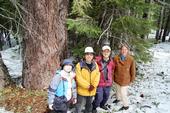- Author: John Hickey
Reposted from the UC Berkeley News
Fire crews work on a wildfire in California. The 2019 fire season could be as destructive as earlier fire seasons. (U.S. Forest Service photo by Mike McMillan under Creative Commons 2.0)
Eight months after the Camp Fire consumed the Northern California town of Paradise...
- Posted By: Jaime Adler
- Written by: Rick Standiford, Susie Kocher, Mike De Lasaux, Jaime Adler

Recently three leaders from the Taiwan Forestry Research Institute (TFRI), a division of Tawain’s Council of Agriculture (COA), traveled to Northern California to meet with UCCE foresters to gain information about our outreach program that they might be able to apply in Taiwan. Dr. Yue-Hsing “Star” Huang, Director of TFRI; Dr. Meng-Ling Wu, Department Chief of Forest Protection; Dr. Gene-Sheng Tung, Assistant Researcher in the Department of Forest Protection spent three days at UC Berkeley, UC Berkeley’s Blodgett Forest Research Station, South Lake Tahoe, and in Quincy and Plumas Counties exploring extension projects and learning how UCCE Foresters initiate and maintain relationships with landowners, managers, conservation groups, and...


